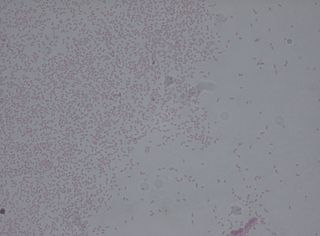
Gypsophila paniculata, the baby's breath, common gypsophila or panicled baby's-breath, is a species of flowering plant in the family Caryophyllaceae, native to central and eastern Europe. It is an herbaceous perennial growing to 1.2 m (4 ft) tall and wide, with mounds of branching stems covered in clouds of tiny white flowers in summer. Another possible source of this name is its scent, which has been described as sour milk, like a baby's “spit-up”. Its natural habitat is on the Steppes in dry, sandy and stony places, often on calcareous soils. Specimens of this plant were first sent to Linnaeus from St. Petersburg by the Swiss-Russian botanist Johann Amman.

Xanthomonas campestris is a gram-negative, obligate aerobic bacterium that is a member of the Xanthomonas genus, which is a group of bacteria that are commonly known for their association with plant disease. This species includes Xanthomonas campestris pv. campestris the cause of black rot of brassicas, one of the most important diseases of brasicas worldwide.

Pseudomonas syringae is a rod-shaped, Gram-negative bacterium with polar flagella. As a plant pathogen, it can infect a wide range of species, and exists as over 50 different pathovars, all of which are available to researchers from international culture collections such as the NCPPB, ICMP, and others.

Pseudomonas savastanoi is a gram-negative plant pathogenic bacterium that infects a variety of plants. It was once considered a pathovar of Pseudomonas syringae, but following DNA-relatedness studies, it was instated as a new species. It is named after Savastano, a worker who proved between 1887 and 1898 that olive knot are caused by bacteria.
Pseudomonas coronafaciens is a Gram-negative bacterium that is pathogenic to several plant species. Following ribotypical analysis several pathovars of P. syringae were incorporated into this species.

Xanthomonas is a genus of bacteria, many of which cause plant diseases. There are at least 27 plant associated Xanthomonas spp., that all together infect at least 400 plant species. Different species typically have specific host and/or tissue range and colonization strategies.

Burkholderia glumae is a Gram-negative, soil-borne, betaproteobacterium.

Pantoea agglomerans is a Gram-negative bacterium that belongs to the family Erwiniaceae.

Clavibacter michiganensis is an aerobic non-sporulating Gram-positive plant pathogenic actinomycete of the genus Clavibacter. Clavibacter michiganensis has several subspecies. Clavibacter michiganensis subsp. michiganensis causes substantial economic losses worldwide by damaging tomatoes and potatoes.
Curtobacterium flaccumfaciens is a Gram-positive bacterium that causes disease on a variety of plants. Gram-positive bacteria characteristics include small irregular rods, lateral flagella, the ability to persist in aerobic environments, and cells containing catalase. In the interest of studying pathogenicity in plants, this species is broken down further into pathovars, which help to better describe the pathogen.
Xanthomonas arboricola is a species of bacteria. This phytopathogenic bacterium can cause disease in trees like Prunus, hazelnut and walnut.

Xanthomonas translucens is a species of phytopathogenic bacteria. It is the causal agent of bacterial leaf streak in of wheat and cereal crop. The bacterium is transmitted as a seed-borne pathogen. The transmission rate is very low but ensures serious outbreaks in the field under suitable conditions. The pathogen is a non-sporing, aerobic, motile, gram-negative, rod bacterium with a single polar flagellum.
Hordeum mosaic virus (HoMV) is a pathogenic plant virus. It affects barley crops.

Plant disease resistance protects plants from pathogens in two ways: by pre-formed structures and chemicals, and by infection-induced responses of the immune system. Relative to a susceptible plant, disease resistance is the reduction of pathogen growth on or in the plant, while the term disease tolerance describes plants that exhibit little disease damage despite substantial pathogen levels. Disease outcome is determined by the three-way interaction of the pathogen, the plant and the environmental conditions.

Xanthomonas campestris pv. vesicatoria is a bacterium that causes bacterial leaf spot (BLS) on peppers and tomatoes. It is a gram-negative and rod-shaped. It causes symptoms throughout the above-ground portion of the plant including leaf spots, fruit spots and stem cankers. Since this bacterium cannot live in soil for more than a few weeks and survives as inoculum on plant debris, removal of dead plant material and chemical applications to living plants are considered effective control mechanisms.
Bacterial blight of cotton is a disease affecting the cotton plant resulting from infection by Xanthomonas axonopodis pathovar malvacearum (Xcm) a Gram negative, motile rod-shaped, non spore-forming bacterium with a single polar flagellum

Xanthomonas oryzae pv. oryzae is a bacterial pathovar that causes a serious blight of rice, other grasses, and sedges.
Andrew O. Jackson is an American plant virologist.
Florida is the largest producer of fresh-market tomatoes in the United States.










